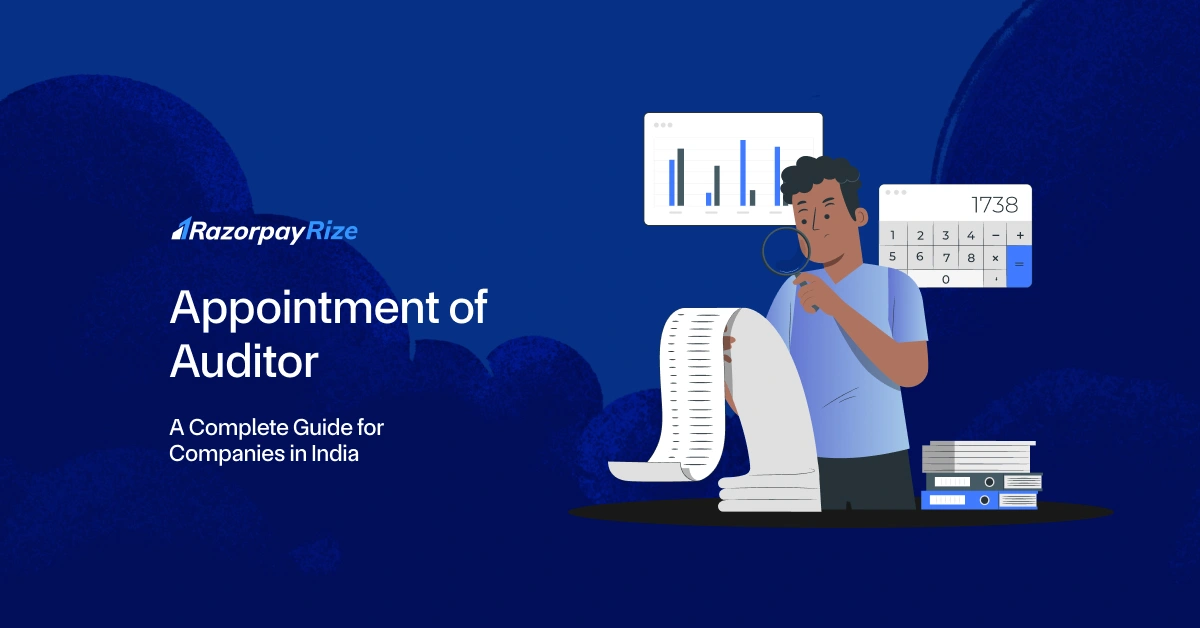Behind every successful company lies the vision and initiative of its promoters—the individuals or entities responsible for bringing the business into existence. Promoters play a pivotal role in the early stages of a company's lifecycle, from conceptualising the business idea to ensuring its legal incorporation and securing initial funding.
Their responsibilities extend beyond just setting up the business; they lay the foundation for the company’s structure, compliance, and future growth. However, with great influence comes great responsibility, as promoters are entrusted with legal and ethical obligations to act in the best interests of the company and its stakeholders.
This blog dives into the meaning, types, roles, duties, and liabilities of company promoters, offering insights into their critical role in shaping successful businesses.
Table of Contents
Definition of Company Promoter
A company promoter is a person or entity that undertakes the responsibility of forming a company. As per legal definitions, a promoter is someone who conceives the idea of the business, takes the necessary steps to incorporate the company, and facilitates its registration.
For instance, if an individual drafts the Memorandum of Association (MOA) and Articles of Association (AOA) for a business and secures initial funding, they qualify as a promoter. Promoters can be:
- Individuals (e.g., founders of a startup)
- Groups of people (e.g., a partnership forming a company)
- Organisations (e.g., a holding company promoting a subsidiary)
Who Are the Promoters of a Company?
Promoters can be anyone involved in the process of establishing a company. This includes:
- Founders – Entrepreneurs or individuals initiating the business idea.
- Investors – Entities that fund the company’s formation and help in structuring.
- Professional Firms – Companies that specialise in managing incorporation and initial stages.
It is important to differentiate between named promoters, whose roles are mentioned in legal documents like the prospectus, and unofficial contributors, who may assist without formal recognition.
Types of Promoters of a Company
Promoters can be classified based on their involvement and expertise:
1. Professional Promoters
These are specialists with expertise in company formation. For example, consulting firms or legal advisors assisting in setting up a company.
2. Occasional Promoters
Individuals who promote companies sporadically, typically when they spot a business opportunity, such as a seasoned entrepreneur launching a startup.
3. Financial Promoters
Entities like venture capitalists or investment firms promote businesses by providing initial funding.
4. Entrepreneurial Promoters
Business owners or founders who initiate the company based on their vision and strategy. An example is a tech founder creating a software startup.
Functions of a Promoter
The role of a promoter is multifaceted. Their primary functions include:
- Identifying a Business Opportunity
Promoters analyse market trends, identify viable opportunities, and decide on the scope of the business. - Preparing Necessary Documentation
Drafting the MOA, AOA, and other legal documents essential for company registration. - Securing Capital and Initial Funding
Approaching investors or institutions to raise funds for the company. - Registering the Company
Ensuring the company’s incorporation by meeting all legal requirements, such as filing with the Registrar of Companies (RoC). - Establishing Operations
Setting up offices, hiring the initial workforce, and laying out the operational roadmap.
Duties of a Company Promoter
Promoters have critical duties to uphold the integrity and governance of a company. These include:
- Acting in Good Faith
They must prioritise the company’s interests over personal gain. - Avoiding Conflicts of Interest
Promoters are obligated to disclose any potential conflicts that may affect the company. - Disclosure of Personal Interests
Any benefits or transactions involving the promoter must be transparently disclosed. - Providing Accurate Information
Misrepresentation of facts during the company’s formation can lead to legal consequences.
Rights of a Promoter
Despite their duties, promoters are entitled to certain rights:
- Right to Indemnity
They can claim indemnity for liabilities incurred during company formation. - Right to Recover Preliminary Expenses
Expenses made for incorporation can be reimbursed. - Right to Remuneration
Promoters can receive remuneration for their services, either as cash or shares.
Liability of a Promoter
Promoters may face liabilities in specific scenarios:
- Civil Liability: Misrepresentation or breach of duties can result in compensation claims.
- Criminal Liability: Fraud or deliberate misconduct can lead to prosecution.
- Public Examination: Promoters may be publicly examined in cases of company insolvency.
- Personal Liability: They can be personally held liable for contracts signed before incorporation if the company does not ratify them.
Difference Between Promoters and Directors
Related Read - Who is a Director of a Private Limited Company?
Real-Life Examples of Famous Company Promoters
1. Dhirubhai Ambani (Reliance Industries)
Dhirubhai Ambani, the visionary founder of Reliance Industries, started the company in 1966 as a small polyester trading firm. Through his entrepreneurial spirit, he transformed it into a global conglomerate spanning petrochemicals, textiles, and telecommunications, making Reliance a household name in India.
2. Narayana Murthy (Infosys)
Narayana Murthy, the co-founder of Infosys, played a pivotal role in establishing one of India’s most successful IT companies in 1981. His commitment to transparency, innovation, and customer-centricity positioned Infosys as a global leader in software services and outsourcing.
3. Elon Musk (Tesla, SpaceX)
Elon Musk is a modern-day promoter known for revolutionising industries through Tesla and SpaceX. By promoting electric vehicles and renewable energy with Tesla and pioneering space exploration with SpaceX, Musk has demonstrated how visionary leadership can disrupt traditional industries and redefine the future.
Frequently Asked Questions
Private Limited Company
(Pvt. Ltd.)
- Service-based businesses
- Businesses looking to issue shares
- Businesses seeking investment through equity-based funding
Limited Liability Partnership
(LLP)
- Professional services
- Firms seeking any capital contribution from Partners
- Firms sharing resources with limited liability
One Person Company
(OPC)
- Freelancers, Small-scale businesses
- Businesses looking for minimal compliance
- Businesses looking for single-ownership
Private Limited Company
(Pvt. Ltd.)
- Service-based businesses
- Businesses looking to issue shares
- Businesses seeking investment through equity-based funding
One Person Company
(OPC)
- Freelancers, Small-scale businesses
- Businesses looking for minimal compliance
- Businesses looking for single-ownership
Private Limited Company
(Pvt. Ltd.)
- Service-based businesses
- Businesses looking to issue shares
- Businesses seeking investment through equity-based funding
Limited Liability Partnership
(LLP)
- Professional services
- Firms seeking any capital contribution from Partners
- Firms sharing resources with limited liability
Frequently Asked Questions
What are the promoters of a company?
Promoters are individuals, groups, or entities that take the initiative to establish a company. They are responsible for conceiving the business idea, arranging initial funding, completing legal formalities, and ensuring the company is incorporated.
Can a promoter of a company be the independent director?
No, a promoter cannot serve as an independent director of the same company. According to Section 149(6) of the Companies Act of 2013, independent directors must not have any material or relationship with the company, its promoters, or its directors.
How to become a promoter of a company?
To become a promoter of a company, you need to:
- Conceive a Business Idea: Identify a viable business concept or opportunity.
- Conduct Feasibility Studies: Evaluate the market potential, resources, and legal requirements.
- Prepare the Incorporation Process: Draft documents such as the Memorandum of Association (MOA) and Articles of Association (AOA).
- Arrange Capital: Secure the initial funds needed to start the business, either through personal investment, partnerships, or external sources.
- Register the Company: File for incorporation with the Registrar of Companies (ROC) as per the applicable laws in your jurisdiction.
How to find promoters of a company?
To identify the promoters of a company, you can:
- Check Company Filings: Promoters are often named in the incorporation documents, such as the MOA, AOA, or prospectus.
- Review Annual Reports: Public companies disclose promoter details in their annual reports under the shareholding pattern section.
- Visit MCA (Ministry of Corporate Affairs): In India, you can access promoter details on the MCA website by searching the company’s filings.
- Examine Stock Exchange Filings: For listed companies, stock exchanges (like NSE and BSE) provide shareholding data that identifies promoters.
What is the legal position of a promoter?
The legal position of a promoter is that of a fiduciary agent for the company. While they are not employees or directors, promoters owe a duty of good faith and fairness to the company. Their legal responsibilities include:
- Acting in Good Faith: Avoiding conflicts of interest and prioritising the company’s interests.
- Disclosing Personal Interests: Declaring any personal benefits or profits made during the promotion process.
- Liability for Misrepresentation: Promoters can be held liable for false statements in the prospectus or incorporation documents.
- Compliance with the Law: Ensuring all legal formalities are followed during company formation.
What is the difference between the promoter and the founder of the company?
In many cases, a founder can also act as a promoter, but not all promoters are founders.
.webp)







_.webp)







